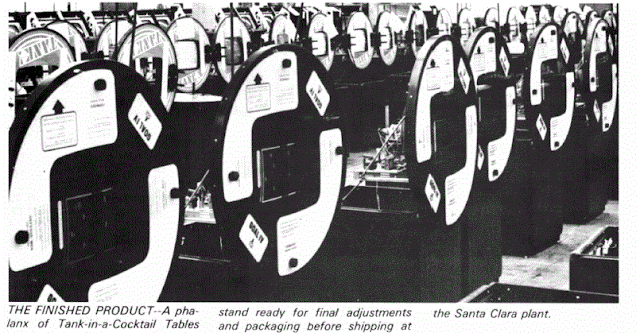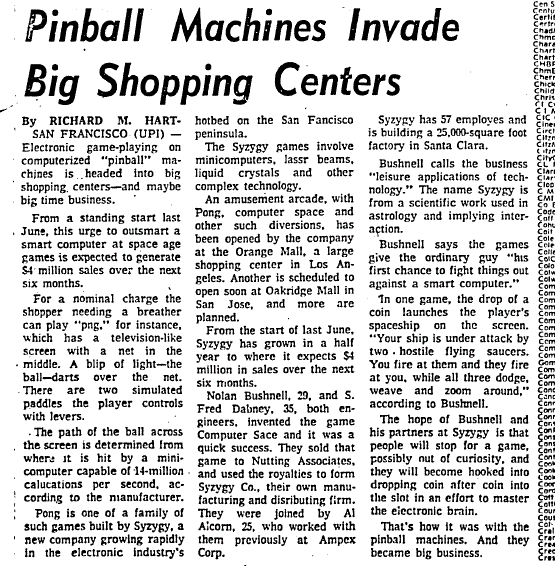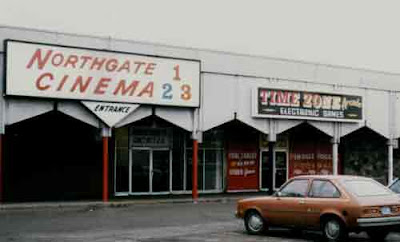Nolan Bushnell
wasn't the only person working on a commercial version of Spacewar at the time. Elsewhere in the valley, a recent Stanford
graduate and Spacewar veteran named
Bill Pitts was createing a version on the PDP-11 computer, which had been
released by DEC in 1970. While Pitts had a degree in Statistics, his real love
was computers. At the time he attended Stanford, they did not offer an
undergraduate degree in Computer Science (and wouldn't until the mid-1990s). In
order to attract students, the Statistics department allowed undergraduate
students to take graduate-level Computer Science classes and count them towards
a Statistics degree. At a time when Computer Science courses were rare at any
college, many students jumped at the chance to study the field in any way they
could. In many ways, Pitts was a prototypical hacker.
[Bill Pitts] My
first two years at Stanford (I started there in 1964), my hobby on campus was
breaking into buildings and exploring the steam tunnels [under the campus]…I
had conquered all the buildings on campus and one day I was driving through the
hills behind Stanford and I noticed this new building I’d never seen before. It
was a big, fancy building out in the hills but I could tell by the writing on
the sign that it was a Stanford building so I went back at 11:00 at night to break in but unfortunately all
the doors were open, the lights were on, and people were in there working. So
there was no challenge as far as breaking into the building goes but what they
had was a nice PDP-6 computer – the first really successful time-sharing system
from DEC. That was the Artificial Intelligence project that John McCarthy had
started and it had only been in that building for a couple of months.
After his groundbreaking work at MIT, McCarthy had taken
his AI project to Stanford, bringing with him a number of students (as well as
fellow AI-pioneer Marvin Minsky). Among them was Spacewar creator Steve Russell, who was placed in charge of the
project’s ever-changing timesharing mainframe. Needless to say, Spacewar found its way onto any number
of Stanford mainframes and a core of dedicated players soon emerged. As had
been the case with their predecessors at MIT, the main problem for Stanford’s
fledgling community of hackers was gaining access to the mainframes.
[Bill Pitts] In
order to use the time-sharing system, there was a sign-up procedure. You had to
sign up for one or two DEC tapes (we didn’t have disk drives then), some amount
of core memory and a teletype. You’d sign up for all these resources and then
you’d have them for the next hour or two. As an undergraduate, I had no
privileges to sign up – only graduate students could do that, but because I was
a Stanford student, I could use any idle resources that weren’t being used by
someone else. So I ended up going there at 10:00 or 11:00 at night and I’d stay
until 6:00 in the morning. I was often the only one there and had the whole
machine to myself. So I stopped going to day classes and started living in the
AI lab.
After discovering Spacewar
(which he’d first seen on a PDP-1 elsewhere on campus), Pitts showed the game
to a high-school friend named Hugh Tuck. Tuck was impressed with the game and
speculated that if it ever got to where they could make a coin-operated
version, he and Pitts could make a lot of money. A few years later, when DEC
released the PDP-11 (at a cost of around $10,000), Pitts realized that his
friend’s dream could become a reality.
In June of 1971 Pitts and Tuck formed Computer
Recreations Inc. with plans to build a coin-operated version of Spacewar. For the next three and a half
months, the two worked on the game. The hardware consisted of a PDP-11/20 computer with 8k of memory,
a Hewlett Packard 1300A Electrostatic Display, and a simple point-plotting
display interface (designed by Ted Panofski).
At the same time, of course, Nolan Bushnell was working on his own
version of the game. Pitts and Tuck, however, wanted to take a different
approach.
[Bill Pitts] Nolan Bushnell and I had
both played Spacewar at Stanford and
we were both bringing it to the masses. His way of doing it was to cut all the
corners necessary to build a machine that could be sold to operators for under
$1,000. I give him a lot of credit. I think that his real knack, which he
demonstrated on a number of occasions, was to be able to take the current state
of some complex technology and pull from that something that could be taken to
the masses and generate money. My goal was to bring Spacewar in all its glory to the masses. I was driven more by
wanting to bring the real thing to market at opposed to making money. I see
Nolan Bushnell as an entrepreneur with both an engineering and a business
aspect to him and I see myself more as an engineer.
Bushnell
heard that we were building ours at the same time he was building his. Through
some mutual friends, he contacted us and said “Come on over and I’ll show you
what I’m doing because I (think) that if you’re using a PDP-11 and
Hewlett-Packard displays, you’re spending a lot of money to build a single
system and I want you to be aware of what I’m doing because I’d hate to see you
lose all of your money.”
So
we went over to Nutting Associates in Mountain View. He had started months
before and he had some prototypes up and running. We played the game and I
thought it was incredible what he was able to build and sell for under $1,000
but it wasn’t Spacewar. He had to cut
so many corners that it didn’t really have good playing characteristics, but I
appreciated the fact that he had called us over and warned us.
After visiting Nutting, Pitts and Tuck
got back to work, and by September, the game was complete. Pitts’ and Tuck's
game was much more expensive than Busnhell's. Luckily, Tucks’ family was able
to provide funding for the project, whose total cost came to around $20,000. In addition to the $14,000-plus low-end PDP-11,
the game included a similarly expensive (circa $3,000) Hewlett-Packard monitor.
[Bill Pitts] The tube it used was a
Hewlett-Packard 1310, which is like a large oscilloscope tube. The difference
being that most large vector tubes used electro-magnetic deflection and this
one used electro-static defection, which meant that you didn’t have all the
inertia of a big coil at the back. The bandwidth of the tube was 10 to 100
times faster than an electro-magnetic display. For programming reasons, that
was a whole lot easier because when the beam wraps around from one side to the
other, the tube is so fast that it just does it immediately, whereas with an
electro-magnetic tube, you have to detect when it goes off one edge and you
need to stop and wait for the beam to get around to the other side before you
can continue drawing.
While much of the computer hardware
for Galaxy Game was expensive, the
game-specific hardware was sometimes hard to find. Coin-boxes came courtesy of
veteran jukebox manufacturer Rowe International, who had heard about Pitts’
project and was eager to provide help. Joysticks were a different story.
[Bill Pitts] There was a place called
J&H Outlet in San Carlos. It was the typical military surplus place – they
had all sorts of electronic stuff and airplane parts and who knows what and
they had it there bunch of joystick-like devices that were out of B-52s from
the 1950s or 1960s. I guess they had been obsoleted or worn out and I was
buying them at J&H outlet in 1971. They controlled something to do with the
radar system on the B-52. There’s a scene in Dr. Strangelove with James Earl
Jones…
when the nuclear bomb is detonated and there’s a fire, and in that scene I
remember seeing the joystick. These joysticks got heavily modified. They’re
actually very heavy joysticks. In the first game we didn’t modify them very
much and they were very unreliable but in the second version I sent them to a
machine shop and we had a really good engineer there do the engineering for us.
They were analog joysticks originally and we converted them to where they were
completely digital and they were very reliable.
After
completing the hardware, the duo packed it into a walnut cabinet designed by an
engineer in Palo Alto. The cabinet allowed the player to sit down while playing
- a feature designed to encourage players to play for long stretches, resulting
in more revenue. With the cabinet and hardware complete, Pitts and Tuck were
ready to take their creation public.
Because of the raging anti-war sentiment on campus, the two decided to change
the name from Spacewar to Galaxy Game. In September of 1971, they
installed the game in Stanford’s Tresidder Union (Computer Space had been placed out on test in August). The PDP
computer that controlled the game was actually located in the attic of the
union and connected to the game console via 100 feet of cable. The game became
an instant hit. At ten cents a game (three games for a quarter) it would take a
long time for Pitts and Tuck to recoup the $20,000 they’d spent building it,
but that didn’t seem to faze them. The game was wildly popular with the
Stanford students with people sometimes waiting an hour to play, lining up
their quarters atop the cabinet to reserve a spot (a practice that would become
standard in video arcades across the country in years to come). True to its
mainframe predecessor, Pitts’ coin-op version contained a host of options the
user could select – though in a much more user-friendly format.
[Bill Pitts] In
the original [mainframe] version, in order to get negative gravity for example,
you would go in there with a debugger and you’d know the magic location of
where the gravity constant was and you’d stop the program and change the
number, making the gravity stronger or weaker and you could even make it
negative, but you had to be a programmer to go in and change these things. In
my version…what I did was to have a bunch of buttons between the joysticks that
allowed you to select the various options. There were like 16 different setting
for the gravity field, you could select the level of thrust your engines had,
you torpedo velocity etc. When the ship got to the edge of the screen, it could
wrap around, you could bounce off, or you could blow up. One of the interesting
variations was to have negative gravity, which was always pushing you to the
edge of the screen, and to have the edge set to blow you up.
Another feature from the original was the realistic star
field (which included Polaris in the center of the screen in addition to the
sun). The player’s ship was controlled by a joystick to control rotation and
thrust with a button on the front to fire the lasers and another on top to
engage the hyperspace feature. A dime (or quarter) brought you a certain amount
of fuel, which was consumed at varying rates depending on what you did.
Before long, Galaxy Game was drawing crowds of
Stanford students and became so successful that Pitts and Tuck changed their
original plans for the game. Similarly to Nolan Bushnell, the designers soon
decided that the only way to turn a profit on the game was to allow one
computer to power multiple terminals so they designed a second version of Galaxy Game using a more powerful
display interface that would allow the computer to drive four to eight
terminals.
[Bill Pitts] When
we built the first machine, we didn’t expect to make money. We knew it was
costing a lot of money to build one machine and what we wanted to do was see
how much business we could generate and then we would go back and figure out
how cheap we had to make the machine to really be successful but when we
encountered such a huge wave of enthusiasm from the people that were playing
the game, we forgot what our plan was. We were just out of college and were not
business people. So we decided that we would amortize the cost of the computer
by having it drive up to four consoles and each console had two players. So we
embarked on building version two and that had fiberglass casing and a lot more
tooling and meant buying another computer and more displays and that’s how we
ran up to $60,000 in expenses. While it could have driven four consoles, what
we ended up putting at Stanford (because it was all they had room for) was the
2nd version that had a PDP-11 inside one of the fiberglass cases and
it drove both systems. You could either drive those two consoles as two totally
separate games or you could interlink the two and have four player games where
they were all fighting each other.
Placed in a blue fiberglass case designed by Hugh Tuck (who had a mechanical
engineering degree from Cal Poly), this new version was installed in the
Tresidder Union coffee house in June of 1972. This second version included some
new features, such as being able to increase the rotation and thrust speeds by
holding the joystick in position for a certain amount of time. Despite the
features, the second unit failed to match the success of the original.
[Bill Pitts] The
system at Stanford in the Student Union always did well. The other system I
had, I moved it all over the place and I never did well. Somehow the Stanford
community really appreciated this game and they were willing to read a
legal-sized document of instructions. In other places, they just didn’t want to
do that.
Eventually, the second unit made its way back to the
student union coffee house, where it remained until May of 1979, taking in
around $60,000.Unlike Computer Sapce,
Galaxy Game never saw the outside of
the Stanford campus and only two units were ever built. Pitts and Tuck realized
from the start that their creation was too expensive to be commercially viable
on a large scale (the $60,000 in revenue generated by the second unit was
barely enough to cover the cost of building it) and never tried to market the
idea to any coin-op manufacturers. The duo's intention had never been to create
a game for mass-production, but to produce a coin-op version of the mainframe
classic realistic in every detail no matter what the cost. In that, they succeeded admirably








































.jpg)
.jpg)

